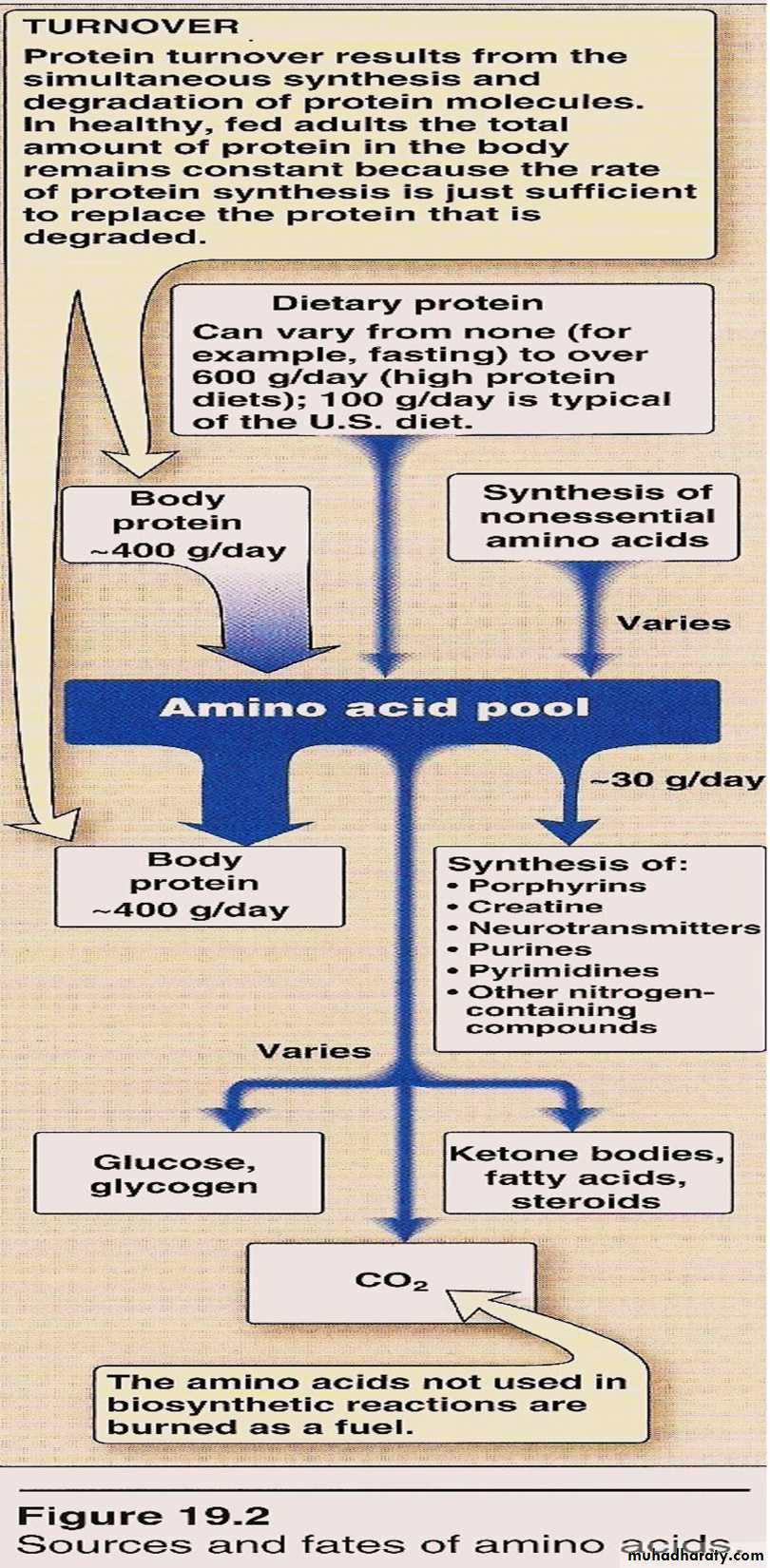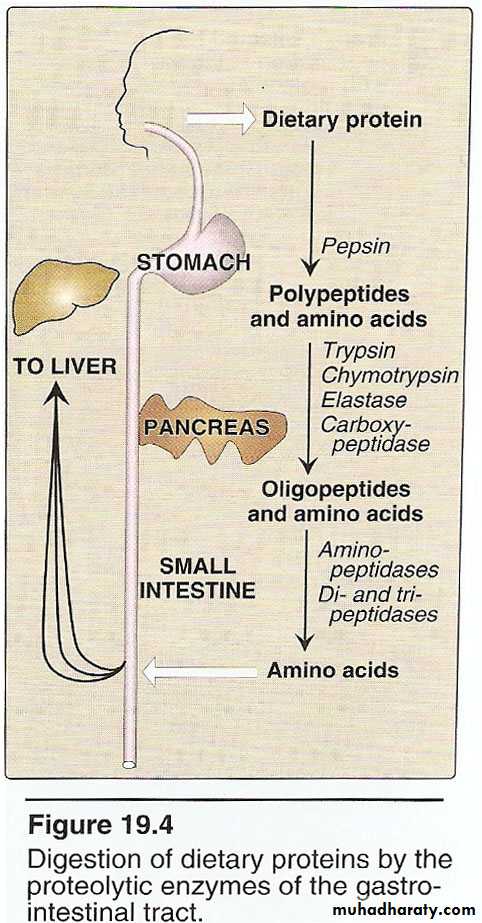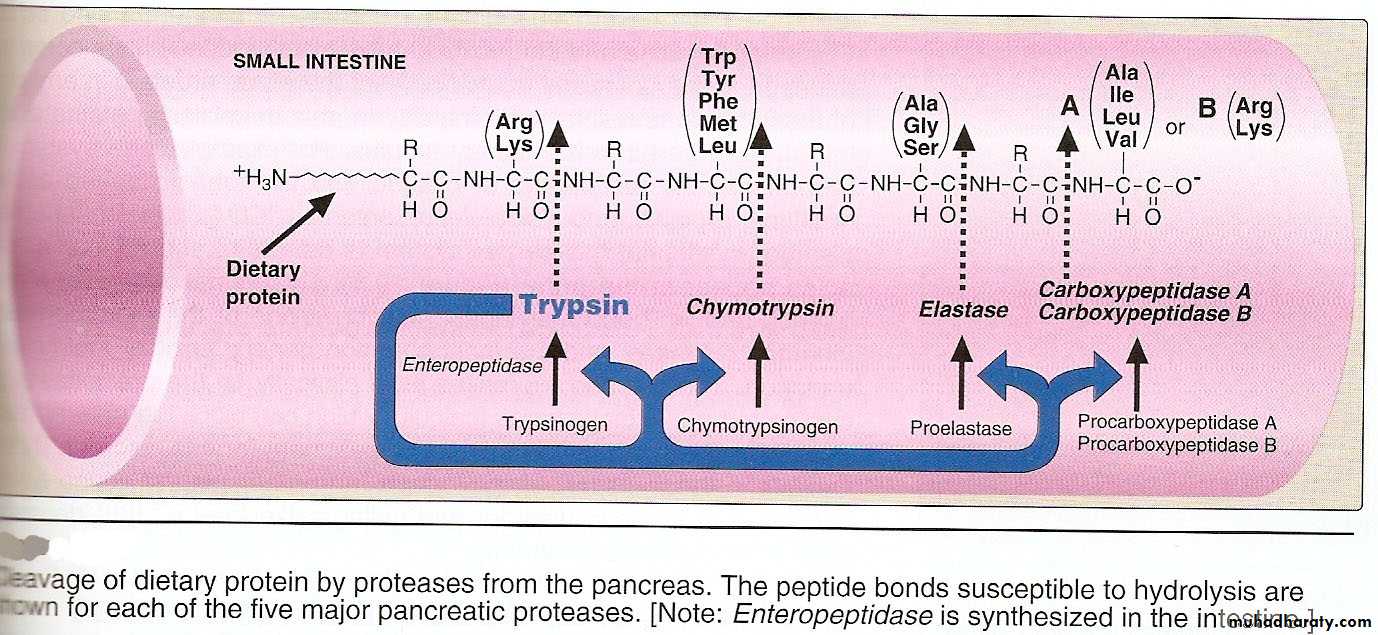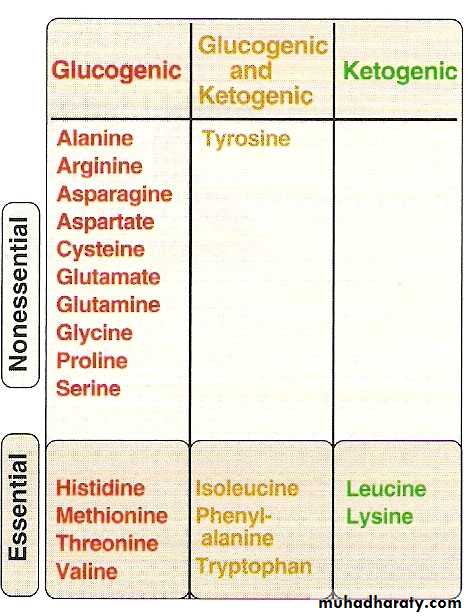Amino Acid Metabolism
• A• m
• I
• n
• o
• A
• c
• I
• d
• S
• M
• E
• T
• A
• B
• O
• L
• I
• S
• M
Free template from www.brainybetty.com
2
• A
• m• I
• n
• o
• A
• c
• I
• d
• S
• M
• E
• T
• A
• B
• O
• L
• I
• S
• M
Objectives:
1.To study Amino Acid Metabolism
2. Overall Nitrogen Metabolism.
3.Digestion & Absorption of Dietary Protein.
4. Removal of Nitrogen from Amino Acids.5.Urea cycle and Its disorders.
6. Metabolism of Ammonia.7. Fate & Metabolism of individual Amino Acids.
• A• m
• I
• n
• o
• A
• c
• I
• d
• S
• M
• E
• T
• A
• B
• O
• L
• I
• S
• M
Introduction
Unlike fat and carbohydrate, Amino Acids are not stored in the body, Protein that exist is to maintain the supply of AA for future use.
AA. Must be supplied from the diet(Exogenous)
OR
Catabolism of normal protein……….(Endogenous).
What about the Excess?
• A
• m• I
• n
• o
• A
• c
• I
• d
• S
• M
• E
• T
• A
• B
• O
• L
• I
• S
• M
The excess enter 2 Phase
Phase1………
Removal of α Amino Acids
Transamination&Oxidative deaminationAmmonia & α Ketoacids (Carb. Skeleton)
Portion of Amm. Excreted in the urine but most of it used in synthesis of Urea.• A
• m• I
• n
• o
• A
• c
• I
• d
• S
• M
• E
• T
• A
• B
• O
• L
• I
• S
• M
Phase2……………
α Keto Acids
Common intermediate of energy producing metabolic pathway
• A
• m• I
• n
• o
• A
• c
• I
• d
• S
• M
• E
• T
• A
• B
• O
• L
• I
• S
• M
Amino Acid Pool
• AA provided by degradation of protein(Endogenous)
• AA provided by dietary protein (Exogenous).
3. Synthesis of non essential AA.
Next Figure
• A
• m
• I
• n
• o
• A
• c
• I
• d
• S
• M
• E
• T
• A
• B
• O
• L
• I
• S
• M
•
• A
• m• I
• n
• o
• A
• c
• I
• d
• S
• M
• E
• T
• A
• B
• O
• L
• I
• S
• M
R= alkyl or heterocyclic group
General formula
• A
• m
• I
• n
• o
• A
• c
• I
• d
• S
• M
• E
• T
• A
• B
• O
• L
• I
• S
• M
Peptide bond
Peptide bond : 2 or more AA
Poly peptide > 10 AA
• A
• m
• I
• n
• o
• A
• c
• I
• d
• S
• M
• E
• T
• A
• B
• O
• L
• I
• S
• M
Formation of Peptide bond:
The bond formed between two amino acid is called peptide bond.
When 2 A.A. are joined together di-peptide will form , if 3 A.A. are joined together tri-peptide will form.
If 2-10 A.A. are joined together oligo-peptide is formed
.
If it is more than 10 it is called poly-peptide.
Poly peptide are large peptide chain containing large no. of peptide bond less than 100 A.A. residue.
If the A.A. residue is more than 100 A.A. it is called protein.
• A• m
• I
• n
• o
• A
• c
• I
• d
• S
• M
• E
• T
• A
• B
• O
• L
• I
• S
• M
A-non migrating neutral( mono amino – mono carboxylic )
* aliphatic straight chain and branched chain
glycine , alanine ,valine
* aromatic phenyl alanine tyrosine tryptophan
* sulfur containing AA cysteine cystine methionine
B-basic AA lysine arginine histidine
C-Acidic AA Aspartic A. Glutamic A.
Imino Group(Heterocyclic AA) Proline Hydroxyproline
Classification 3 groups
• A
• m
• I
• n
• o
• A
• c
• I
• d
• S
• M
• E
• T
• A
• B
• O
• L
• I
• S
• M
• Nonessential
• Essential
• Alanine
• Arginine*
• Asparagine
• Histidine *
• Aspartate
• Valine
• Cysteine
• Lysine
• Glutamate
• Isoleucine
• Glutamine
• Leucine
• Glycine
• Phenylalanine
• Proline
• Methionine
• Serine
• Threonine
• Tyrosine
• Tyrptophan
*The amino acids Arg, His are considered “conditionally essential”
• A
• m
• I
• n
• o
• A
• c
• I
• d
• S
• M
• E
• T
• A
• B
• O
• L
• I
• S
• M
Digestion Of Dietary Protein
Proteins are generally too large to be absorbed by the intestine, they must be hydrolysed to give their constituent AA which can be absorbed.
Stomach
Stomach: the gastric juice and the HCL PH(2-3) too dilute to hydrolysed, In the serus cells pepsinogen is activated to pepsin or auto catalytically by other pepsin molecules that have already activated. Pepsin releases peptides and
few AA.
Pancreas: large polypeptides produced in the stomach are further hydrolysed or cleaved into oligopeptide and AA by the action of pancreatic proteases, these enzymes activated by 2 hormone cholecystokinin and secretin
Trypsinogen activated into trypsin.
Pancreas
Intestine
• A
• m
• I
• n
• o
• A
• c
• I
• d
• S
• M
• E
• T
• A
• B
• O
• L
• I
• S
• M
Intestine : In the intestine luminal surface contain aminopeptidases that repeatedly cleaves the oligopeptide to produce free AA and small peptide.
• A
• m• I
• n
• o
• A
• c
• I
• d
• S
• M
• E
• T
• A
• B
• O
• L
• I
• S
• M
Absorption
Free AA are taken into the intestinal cells by Na-linked
secondary transport system. Di-and tri peptides are
taken up by H+- linked transport system. The peptides
are hydrolyzed in the cytosol to AA before being
released in to the portal system .
Thus, only free AA are found in the portal vein after meal containing protein . These AA are either metabolized by the liver or released into the general circulation. Branched chain AA are important examples of AA that are not metabolized by the liver and sent from the liver into the blood.
• A
• m
• I
• n
• o
• A
• c
• I
• d
• S
• M
• E
• T
• A
• B
• O
• L
• I
• S
• M
•
Specificity;tryp cleaves the carbonyl gp of pptide contributed by ar.,ly
• A
• m• I
• n
• o
• A
• c
• I
• d
• S
• M
• E
• T
• A
• B
• O
• L
• I
• S
• M
Glucogenic &Ketogenic Amino Acid
Glucogenic AA: whose catabolism produce pyruvate or one of the intermediates of the citric acid cycle.These intermediates are substrate for gluconeogenesis,which can give rise to glucose or glycogen in the liver or glycogen in the muscles.
Ketogenic AA: whose catabolism produce acetoacetate or one of its precursor acetyl coAor acetoacetyl coA.
Acetoacetate is one of the ketone bodies which also include B-hydroxybutyric acid and acetone.
only leucine and lysine are purely ketogenic .
Next Fig
• A
• m• I
• n
• o
• A
• c
• I
• d
• S
• M
• E
• T
• A
• B
• O
• L
• I
• S
• M
Glucogenic &Ketogenic Amino Acid
• A
• m• I
• n
• o
• A
• c
• I
• d
• S
• M
• E
• T
• A
• B
• O
• L
• I
• S
• M
In conclusion the catabolism of the AA. Found in protein pass through different steps
• Removal of α AA.
2. Break down of the resulting carbon skeleton.
These pathways form seven intermediate products.
oxaloacetate α ketoglutarate Pyruvate FumarateSuccinyl CoA Acetyl CoA





